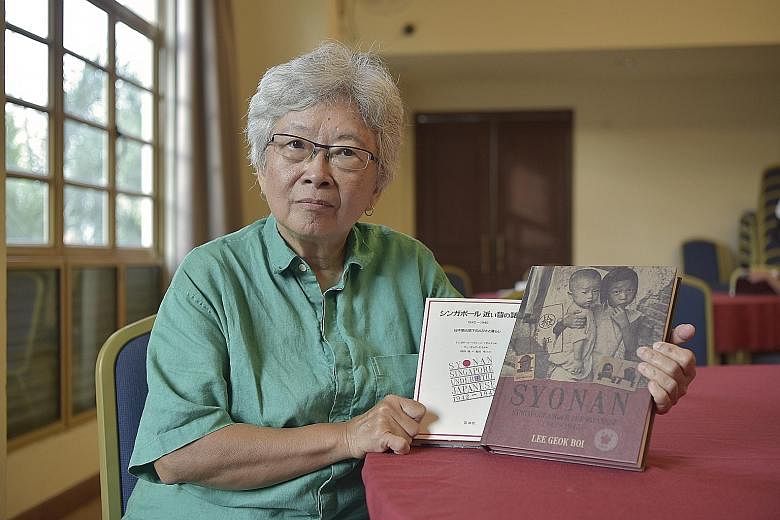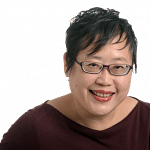SYONAN: SINGAPORE UNDER THE JAPANESE - 1942-1945 (SECOND EDITION)
By Lee Geok Boi
Singapore Heritage Society and Landmark Books/Hardback/ 204 pages/$35 with GST from Books Kinokuniya or on loan from the National Library Board under the call number English 940.535957 LEE
A statue of Guan Yin, the goddess of mercy, likely spared the life of Mr Lee Thian Leong after Singapore fell to Japan in February 1942.
Mr Lee, who died aged 96 on Aug 22, was the father of Singaporean author Lee Geok Boi, a former journalist at The Straits Times (ST) who has since become the nation's foremost chronicler of the Japanese Occupation here.
Lee, 71, has just released the second edition of her 1992 book Syonan, which was the first she wrote.
-
A deeper look at ageing
-
Professor Kua Ee Heok, Singapore's doyen in the field of studying the lot of the elderly here, particularly their experience with dementia, will speak on his new book, Colours Of Ageing, at this month's Big Read Meet.
Prof Kua, a former chief executive and medical director of the Institute of Mental Health here, is now the Tan Geok Yin Professor of Psychiatry and Neuroscience at the National University of Singapore's Department of Psychological Medicine. He is also a senior consultant psychiatrist in the National University Health System and is on the World Health Organization's team for the Global Study of Dementia.
Join him and The Straits Times senior writer Cheong Suk-Wai in The Possibility Room, Level 5 National Library Board (NLB) headquarters at 100 Victoria Street on Sept 27 from 6.30pm. Sign up for it at any NLB e-Kiosk or go to www.nlb.gov.sg/golibrary and look for "The Big Read Meet" there.
She has since written, edited or ghostwritten about 20 other books, including cookbooks, although she has not been keeping count.
Her late father was a 22-year-old student at the onset of the Occupation. Shortly after the fall of Singapore, a Japanese military officer entered his home and saw the family's statue of the goddess, whom the Japanese revere and know as Kannon or, more formally, Kanzeon.
The officer then advised Mr Lee not to heed his fellow officers' call-up then of all Chinese men between the ages of 18 and 50. That call-up ended in Sook Ching (Chinese for "purge through cleansing"), in which the Japanese shot dead many of the Chinese men they had corralled. Some estimate that between 5,000 and 25,000 men perished in Sook Ching.
In an interview at her Pasir Ris flat last Thursday, Lee said her father and his family fled to Penang after the officer's intrusion. There, he met and married her mother. Lee was born in 1946 and her parents returned to Singapore with her when she was six months old.
After some 10 years with ST, including as a sub-editor, she went freelance in 1989.
Then in 1991, while she was "writing, editing, taking photographs" for the Singapore Heritage Society's newsletter Roots, the National Archives of Singapore (NAS) through the society asked if she would write a book on the Japanese Occupation, to be published by early 1992, to commemorate the 50th anniversary of the fall of Singapore.
Lee, a single mother of two daughters, had just six weeks to write it. She roped in her younger daughter Savitri Santhiran, who had then just finished her O-level examinations, to help her research it. Ms Santhiran, now 42, is a librarian married with two sons in St Paul, Minnesota.
In doing so, Lee was among the very first writers here to tap into what she calls "the huge trove" of interviews which the Oral History Department did with survivors of the Japanese Occupation from all walks of life.
At that time, she was told, some academics in Singapore "thought that oral history is not really history; you have to have it all in official documents, neatly printed out from some government department which says, 'This is what happened.'
-
Five questions this book answers
-
1 Why did Singapore fall to the Japanese?
2 How did the Japanese sow ill will among Singapore's communities during World War II?
3 What did it take to survive the Japanese Occupation?
4 How do soldiers on both sides look back at the Occupation?
5 How has Japan's war on Asia affected the region's relations with the rest of the world since?
"But to me, that is nonsense. If I lived through that experience, I don't care what your official documents say... Why should you believe what's written on paper just because it's on paper?" she said.
While this new book is ostensibly the second edition of 1992 Syonan, she stressed that it is "an entirely different book" because first, it has a new angle - that is, the legacies of Japan's war in Asia; second, she saw work on this edition as a way to "fix the shortcomings" of the first; and, last but not least, the Oral History Department gave her transcripts of its fresher interviews, including some done after 2005 with a few Japanese survivors who, as she put it, "perpetuated the horrors" of the Occupation.
Her second book on the Occupation, The Syonan Years, came after the NAS asked her to write the captions for exhibits at the former Ford Factory gallery, when it opened the gallery to the public in the mid-noughties. The Syonan Years soon became the primary sourcebook for students and history buffs, but is now out of print.
Early last year, Dr Chua Ai Lin, then president of the society and now its vice-president, asked Lee and Syonan's original publisher, Mr Goh Eck Kheng of Landmark Books, if they would do a second edition of the 1992 book to mark the 75th anniversary of the fall of Singapore this year.
Dr Chua, 43, said that once the duo committed to it, they were determined to make the best job of it. She added that she was delighted the society had the original 1992 team to "update" the book.
Then, earlier this year, just as the book was about to go to press, it was held back. Lee recalled: "The powers- that-be wanted some changes to the manuscript. They felt that some things I had said in the revised manuscript could prove controversial and they wanted changes to be made. And so there was some ding-donging as to how they were to be made... and so, of course, that took time."
She said the potential controversy was that she had written about the possibility that Japan's Emperor Hirohito, who ruled wartime Japan, might have contemplated abdication. Alas, she wrote that at a time when Japan's leaders were wrestling with present Emperor Akihito's announcement that he wanted to abdicate.
In 1996, Lee broke new ground - in Japan, no less, where talk of Japan's wartime culpability is taboo - when Tokyo's Gaifusha Publishing bought the rights to her 1992 Syonan book from the society and released it in Japanese.
Lee, who has visited the Yasukuni Shrine, where the remains of the Occupation's war crime perpetrators are interred alongside Japanese war heroes, said: "I enjoy Japan very much and the Japanese people are wonderful.
"To be fair, even during the Occupation, there were Japanese who did not really like what they had to do. So there have been numerous accounts of how individuals on their own initiative tried to avoid killing people they knew to be innocent."
In a nutshell
THE GOOD
Singaporean author Lee Geok Boi is an assured, clear-eyed writer and she makes the most of her skills to bring the Japanese Occupation alive for readers.
From the first page of this handsome volume, you will likely be galvanised by her deft storytelling, lifted further by her eye for telling details and tight marshalling of various facets of her subject.
It is hard to make the oft-told history of the Japanese Occupation fresh for new generations, but Lee pulls it off by immersing readers in the day-to-day experiences of ordinary people holding their heads up in extraordinary times.
THE BAD
Lee has given such comprehensive overviews of certain aspects of the Occupation that you would be forgiven for thinking that this book is a one-stop primer on the period.
That is not so, especially as an important chunk of those years, that is, the anti-Japanese movements at that time, is largely missing from this tome - under 10 pages, compared with the more than 40 pages she took to cover them in her 2005 book, The Syonan Years.
So you would do well to treat her new book as a people's history of the Occupation and consult other Occupation books (most of which are out of print and so available in hard copies or microfilm in the National Library Board's Lee Kong Chian Reference Library).
These titles include government lawyer Tan Thoon Lip's Kempeitai Kindness (1946), Noel Barber's Sinister Twilight (1968) and Lee's The Syonan Years.


